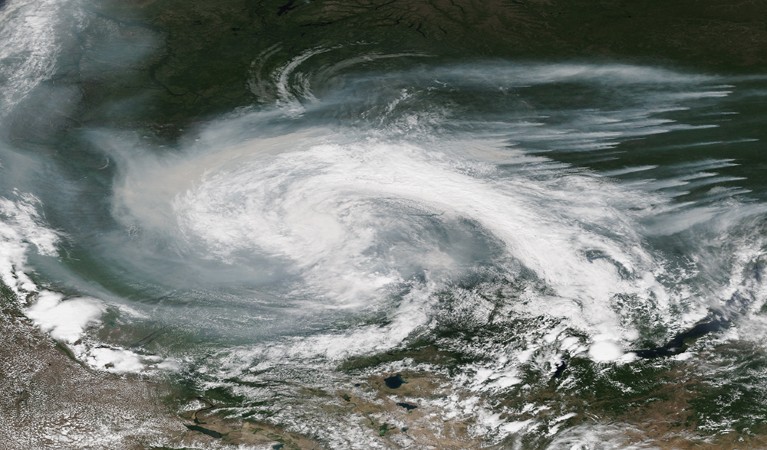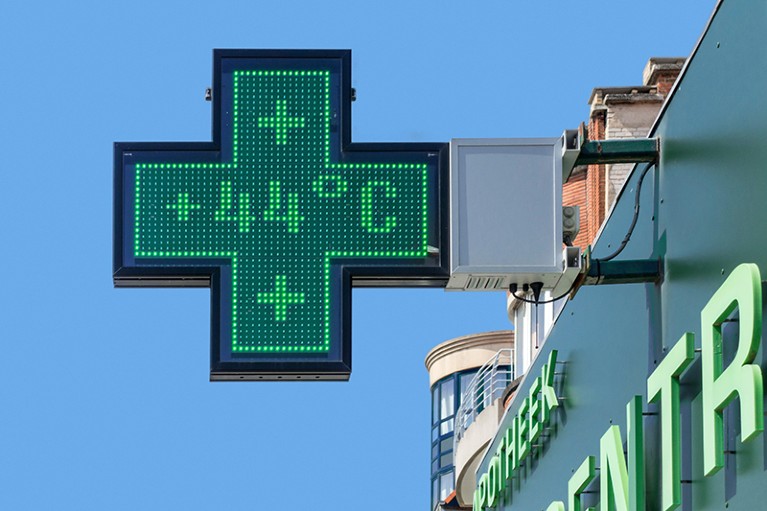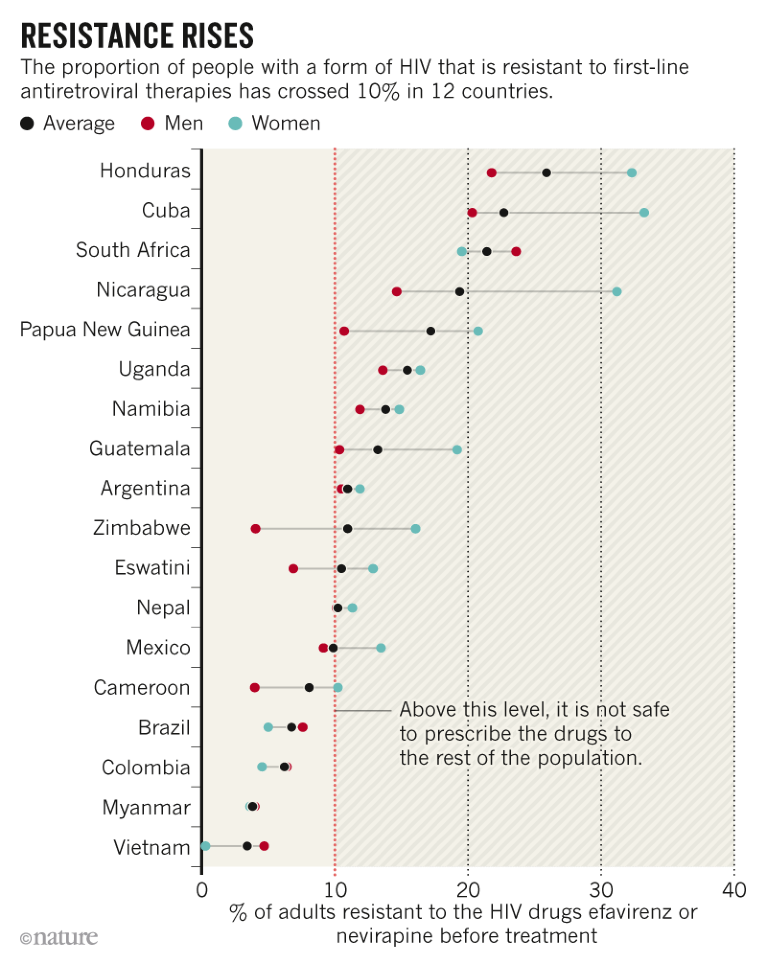EVENTS
Huge wildfires rage across Arctic Wildfires in the Arctic have emitted more than 100 million tonnes of greenhouse gases since early June — equivalent to the annual carbon dioxide emissions of Belgium. Unusually large and intense wildfires in Siberia and Alaska produced an unprecedented 50 million tonnes of CO2 in June and even more in July, according to satellite-based estimates (pictured, smoke from wildfires in Russia). Fires are common at high northern latitudes in Arctic summer, but their number and intensity varies. NASA satellites measure the fires’ intensity, from which scientists can estimate the quantity of biomass burnt and emissions of carbon and particulate matter. Arctic wildfires have emitted an annual average of about 30 million tonnes of CO2 since the turn of the century. There had been no clear upward trend in emissions until the past 3–4 years.

Smoke from wildfires in Russia trapped in a low-pressure weather system.Credit: NOAA
FUNDING
Ebola funding The World Bank will contribute up to US$300 million to help fight the Ebola outbreak in the Democratic Republic of the Congo (DRC). The funds cover roughly half the anticipated costs of an updated response plan that the DRC government and an international consortium intend to finalize in the coming weeks, according to a 24 July announcement. On the same day, the United States Agency for International Development announced $38 million in assistance — including a cash infusion totalling $15 million for the World Health Organization (WHO) — to help combat the Ebola outbreak. The money will help with tasks including preventing and controlling infections in health facilities and training health workers. The moves follow a 17 July decision by the WHO to declare the outbreak, which has claimed more than 1,700 lives, a public-health emergency of international concern.
POLICY
Science law Indonesia’s parliament passed a law on 16 July placing strict obligations on foreign researchers and overhauling science institutions. The law, first proposed in August 2017, requires foreign scientists to do research that is “beneficial for Indonesia”, submit their primary data to the government and include an Indonesian scientist in their projects. Existing policies that required foreign researchers to get a research permit, and to have a material transfer agreement (MTA) to send specimens abroad, have now become law. Most violations will result in permits being revoked, but some tougher penalties could apply, including jail terms for those who transfer specimens without an MTA. The law also establishes the National Research Agency, which will centralize the country’s research funding and subsume several government research institutions. “We are now waiting to hear from the president to execute the plan,” says Muhammad Dimyati, director general of research and development in the country’s research ministry.
RESEARCH
Hybrid embryo Researcher Hiromitsu Nakauchi is the first to receive Japanese government support to create animal embryos that contain human cells, and to transplant the embryos into animal surrogates. Until March, Japan forbade the growth of animal embryos containing human cells beyond 14 days, or the transplantation of such embryos into a uterus. That month, Japan’s education and science ministry issued new guidelines allowing the procedures. Nakauchi, who leads teams at the University of Tokyo and Stanford University, California, plans to grow human cells in mouse and rat embryos. Human–animal hybrid embryos have been made in the United States, but never brought to term. Nakauchi says he will proceed with caution, but his goal is to produce animals with organs made of human cells that can be transplanted into people.
CLIMATE
European heatwave A heatwave in Europe last week smashed weather records in Germany, Belgium (pictured) and the Netherlands, where temperatures reached more than 40 °C. The United Kingdom saw an all‑time high of 38.7 °C. These scorching temperatures came less than a month after a record-breaking heatwave in France caused a new national high of 46 °C, up from 44.1 °C. Average June temperatures in Europe were the hottest ever measured, and July looks set to follow suit. Europe’s temperatures pale in comparison with the 50 °C record set in India last month — and the 54 °C measured in Kuwait and Pakistan in 2017. Last month, the World Meteorological Organization validated these as the third and fourth hottest temperatures measured on Earth.

A thermometer in Belgium shows a reading of 44 °C during a heatwave in Europe last week.Credit: Clement Philippe/Alamy
Emissions deal Four major car makers have reached a deal with the state of California to produce more-fuel-efficient vehicles. The agreement, announced on 25 July, comes as US President Donald Trump’s administration is preparing to finalize a plan that would roll back strict fuel‑efficiency standards enacted under former president Barack Obama. Under the Obama-era rules, car makers agreed to cut vehicle emissions by 4.7% per year from 2022 to 2025. The Trump proposal would freeze the current standards for all vehicle types and sizes after 2020. Under the new deal with California, Ford Motor Company, American Honda Motor Company, BMW of North America and Volkswagen Group of America have all agreed to cut greenhouse-gas emissions by 3.7% per year from 2022 to 2026. It remains unclear whether other car manufacturers will sign up.
SPACE
Private launch i-Space, a rocket company in Beijing, has become the first commercial firm from China to launch payloads into orbit. The company’s rocket, called Hyperbola-1, blasted off from the Jiuquan launch site in northwestern China on 25 July. It placed several satellites into orbit around Earth, including a radio satellite developed by an amateur radio group and the Beijing Institute of Technology. i-Space hopes that Hyperbola rockets will help to bolster China’s burgeoning commercial space industry. In June, the Chinese government laid out regulations to guide the development and launch of private rockets, including how to ensure safety during launches and reduce any possible space debris. Since 2018, two other Chinese firms have tried, but failed, to achieve orbit.
Wind satellite The European Space Agency (ESA) has switched to a back-up laser for its Aeolus satellite, which maps winds around the globe using a technique that has never been applied before. Aeolus uses its ultraviolet laser to send light pulses into the atmosphere, and measures shifts in the wavelength of light that bounces back; this gives the speed and direction of the winds below. The satellite launched in August 2018, but its main laser soon began losing power. Mission controllers switched to the back-up instrument, which so far seems to be working well, ESA said on 23 July. Meteorologists hope that Aeolus’s data will improve weather forecasts, because the lack of detailed wind measurements is one of the biggest gaps in the Earth-observing system.
Mars probe The Arab world’s first Mars mission, the Hope probe, is scheduled for launch in July 2020, the chair of the United Arab Emirates (UAE) Space Agency, Ahmad al-Falasi, has confirmed. The spacecraft will launch from Japan, and is due to reach Mars the following year, in time for the UAE’s 50th-anniversary celebrations. The mission’s science goals include understanding why Mars is losing its atmosphere by tracking the escape of hydrogen and oxygen, and building a global picture of the changing Martian atmosphere. UAE space-agency officials have said that the probe is nearly complete. Al-Falasi was speaking in July, after the UAE’s Falcon Eye 1 Earth-observation satellite failed to launch.
TREND WATCH
Health authorities have uncovered an alarming surge in resistance to crucial HIV drugs. A World Health Organization (WHO) report, published in July, reveals that 12 countries in Africa, Asia and the Americas have surpassed acceptable levels of resistance to efavirenz and nevirapine, which are the backbone of HIV treatment. HIV is routinely treated with a cocktail of drugs, known as antiretroviral therapy, but the virus can mutate into a resistant form. The WHO conducted surveys from 2014 to 2018 in randomly selected clinics in 18 countries, and examined the levels of resistance to these drugs in people who had started HIV treatment during that period. In 12 countries, more than 10% of adults with the virus had developed resistance. Above this threshold, it’s not safe to prescribe these medicines to the rest of the population, because resistance could increase. Overall, 12% of women had drug-resistant HIV, compared with 8% of men. The causes remain elusive, says Silvia Bertagnolio, an infectious‑disease physician at the WHO in Geneva, Switzerland, and co-author of the report. But drug-resistant HIV might develop when people interrupt treatment, she suggests.

Source: HIV Drug Resistance Report 2019 (WHO, 2019)



